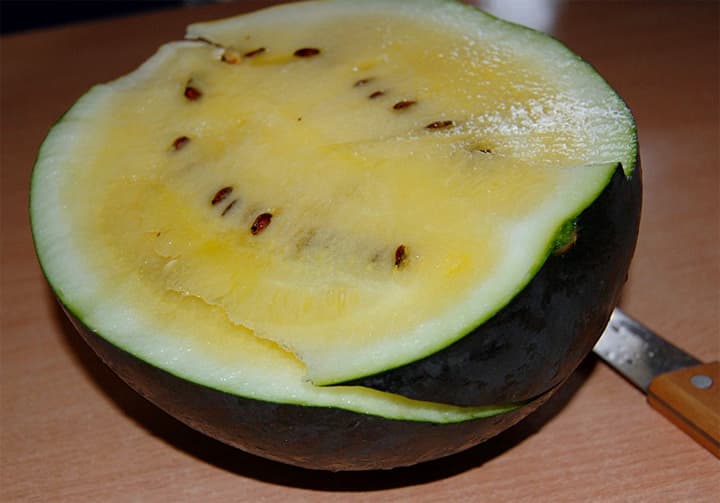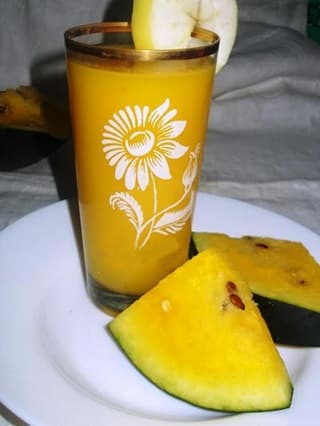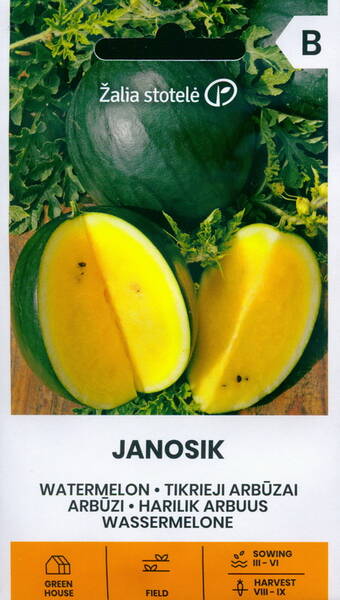Extra-class sugar pulp!
An early variety that tolerates mild frosts. The fruits are round-elliptical, weighing 3.5-5.5 kg, thin-skinned, dark green with dark narrow stripes and a subtle marbled pattern. The flesh is bright yellow, very juicy, sweet, and firm, with a small number of seeds. The plants are branched, with medium-length vines. This variety is characterized by stable and high yields, as well as resistance to low temperatures. It is intended for cultivation in open ground and plastic greenhouses.
1 gram = 12-20 seeds.
PLANT CARE.
Typically, plants require no care for one week after planting, other than ventilation in sunny, warm weather. Ventilation is necessary when temperatures rise above 30°C. To do this, open the greenhouse vents or fold the plastic cover over the ends. About a week later, once the soil has dried, water the plants with warm water, combining this with nitrogen fertilizer (20 g of ammonium nitrate per 10 liters of water; 2 liters of solution per hole). Water very carefully, being careful not to wet the hypocotyls or leaves. Subsequent care for plants in the greenhouse and under the plastic cover differs slightly. We will consider them separately.
In the greenhouse.
Approximately 7-10 days after planting, the plants are supported. The staking system is similar to that used for cucumbers. Watermelon plants are grown as a single stem. Lateral shoots that form in the leaf axils are managed as follows: shoots without fruit buds are removed; shoots with fruit buds are pinched back, leaving 2-3 leaves above the bud. When the plant reaches the trellis, it is pinched back.
It is important to remember that once 2, maximum 3 fruits, approximately the size of a chicken egg, have formed, all remaining ovaries are removed, as the plant will not be able to form more fruits, and they will not have time to ripen.
Melon plants are trained as follows. After pinching the top of the plant during the seedling stage, several side shoots will form. Select one or two of the strongest and train them as the main shoot (tying each to the trellis), then remove the rest. Subsequent training is the same as for watermelon.
In addition to shaping the plants, water them approximately once a week; reduce watering during fruit ripening. In addition to the initial nitrogen fertilizer application (approximately a week after planting), apply at least two more applications of complex fertilizer at intervals of approximately 2-3 weeks.
Sometimes one fruit begins to grow vigorously while the others turn yellow—this indicates inadequate nutrition. When growing in a greenhouse, pay attention to pollination. Insects typically enter the greenhouse through open windows, but if pollination fails, it must be achieved artificially (by transferring pollen from a male flower to the stigma of a female flower).
One of the most important aspects of growing watermelons and melons in a greenhouse is staking the fruit. Typically, the buds, which have grown to the size of a large apple, are placed in the center of a square piece of mesh, the edges of which are tied together and secured with twine to the trellis. Each fruit is then tied in this manner.
Under film cover.
The plastic covering the beds is not removed until approximately mid- to late June (depending on weather conditions). By this time, the plants begin to bloom, and insects need access for pollination. After the plastic is completely removed, the bed is weeded and loosened. The shoots are evenly distributed over the bed surface.
As in a greenhouse, after 1-3 fruits have formed on each plant, all remaining ovaries are periodically removed and the tops are pinched to ensure the plant devotes all its energy to fruit formation. Lateral shoots that do not bear fruit are pruned to allow the plants to receive more light.

Yellow-fruited watermelon. Bot.: Citrullus lanatus L.
Yellow-fleshed watermelon contains dietary fiber, which has a beneficial effect on the digestive system and also cleanses the intestines of waste products and excess fluid.
The fruits do not contain fat, cholesterol, and they They are considered low-calorie foods , which allows the fruit to be consumed during weight loss, as well as by people with obesity and atherosclerosis.
It is worth mentioning that yellow watermelon contains carotenoids, which have a beneficial effect on intercellular metabolism.
The berry also contains folic acid, which is especially beneficial for the female body.
Yellow watermelon cocktail.
You will need:
watermelon (pulp) – 300-400 g
banana – 1 pc.
apple - 1 pc.
cream (you can also use milk, but coconut milk is better) – 200 ml
ice cream (preferably vanilla) – 2-3 tbsp.
1. First, remove the seeds from the watermelon. Peel the banana and apple and cut into pieces.
2. Place everything in a blender, pour in the cream (milk). Blend the mixture until smooth.
3. Add ice cream (if available). It will complement the flavor of the watermelon smoothie nicely, and those with a sweet tooth can add something sweet like honey or sugar.
4. That's it. Let's drink and enjoy.













